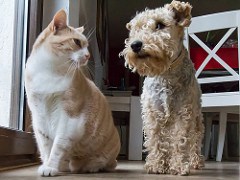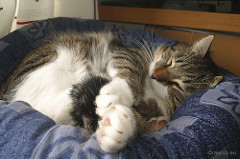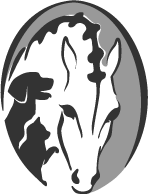A Look Inside Paraplegia
 One condition that truly breaks my heart and has become more prevalent lately involves partial paralysis. Sometimes you’ll see or hear about dogs with three limbs, cats missing legs, and animals in wheelcarts. The last of these tends to be a case of paraplegia. An animal that loses control in the limbs has rarely received a positive prognosis. One reason could be that partial paralysis is a result of any number of conditions. For some it involves long-term disc disease while others could have had a serious trauma or a neurological condition. What I’ve seen more often than not is the case involving a ruptured or herniated disc. These poor animals are the ones that become partially paralyzed quickly and for no apparent reason. As the paralysis continues, organ failure can start, usually with bowel and bladder control being the first to go. Each will vary in presentation and rapidity with progression; nonetheless the outcome doesn’t look good. Up until recently most of these animals are given very few options, limited to serious back surgery, wheel carts, and even euthanasia. For those who are wondering if there are other choices, other paths to try, the answer is an absolute yes.
One condition that truly breaks my heart and has become more prevalent lately involves partial paralysis. Sometimes you’ll see or hear about dogs with three limbs, cats missing legs, and animals in wheelcarts. The last of these tends to be a case of paraplegia. An animal that loses control in the limbs has rarely received a positive prognosis. One reason could be that partial paralysis is a result of any number of conditions. For some it involves long-term disc disease while others could have had a serious trauma or a neurological condition. What I’ve seen more often than not is the case involving a ruptured or herniated disc. These poor animals are the ones that become partially paralyzed quickly and for no apparent reason. As the paralysis continues, organ failure can start, usually with bowel and bladder control being the first to go. Each will vary in presentation and rapidity with progression; nonetheless the outcome doesn’t look good. Up until recently most of these animals are given very few options, limited to serious back surgery, wheel carts, and even euthanasia. For those who are wondering if there are other choices, other paths to try, the answer is an absolute yes.

Animals with paralysis are given a very bleak prognosis, sometimes even appearing hopeless. It is absolutely true that there are cases where paraplegia is unable to be reversed or improved, however, I think this percentage could be dramatically reduced if people were educated on ALL of the options. The option I’d like to discuss is chiropractic care. If in fact the partial paralysis is a result of a disc problem or a neuropathy, chiropractic will make your pet more comfortable and can help bring back control. As with all alternative and conventional practices, each patient is different and each will respond differently. When a disc is involved, however, if pressure can be decreased or removed on the surrounding nerve roots and spinal cord, improvement will be noted. The process is slow, taxing, and will take several treatments and consistent care.
There is no way to speed up a natural process and this will take time. Chiropractic is not a miracle worker. Do not expect to walk in with a limp animal and walk out with a running one. Each treatment will build upon the previous in relieving pressure. Once the pressure is released, the mobility restored, and the spine returned to within normal, the animal should in theory have returned to near full function. Why am I so confident in chiropractic for paralytic animals? Because I have seen first hand what consistent chiropractic care has done for some paraplegic animals. Will this be the case with every patient? No. If a disc is not the culprit behind the paralysis, it may be unlikely that relieving pressure off the spine will in fact bring back function. The truth is you cannot know until you try. Within 3-4 adjustments I am normally able to predict whether an animal will continue to improve with chiropractic or if something else is holding them back. My goal is to help each animal as far as I can and as much as their own body allows them. When it comes to paralysis, it doesn’t hurt to go the alternate route rather than accepting a very hopeless sentence.
 What I will say regarding paralysis is this, I have had animals come back. To see for yourself, visit our Advanced Animal Chiropractic youtube channel, where we have before and after videos. It is not every one, nor is it the norm, and they may not regain full function nor is it something that happens overnight. Very rarely is it done through chiropractic treatment alone. The best way to treat these animals is a myriad of options. The best results I’ve ever seen involved a combination of laser therapy, chiropractic, traditional veterinary medicine, hydrotherapy, and regular physical therapy. Everything helps, and through determination and perseverance of both animal and owner, change can happen. If you have questions or concerns, please do not hesitate to contact us to get more information.
What I will say regarding paralysis is this, I have had animals come back. To see for yourself, visit our Advanced Animal Chiropractic youtube channel, where we have before and after videos. It is not every one, nor is it the norm, and they may not regain full function nor is it something that happens overnight. Very rarely is it done through chiropractic treatment alone. The best way to treat these animals is a myriad of options. The best results I’ve ever seen involved a combination of laser therapy, chiropractic, traditional veterinary medicine, hydrotherapy, and regular physical therapy. Everything helps, and through determination and perseverance of both animal and owner, change can happen. If you have questions or concerns, please do not hesitate to contact us to get more information.
Photo Credit:
Sleeping Dog, Guatape via photopin (license)
Eyeing… via photopin (license)
Millie via photopin (license)
Manchmal könnte ich schmelzen via photopin (license)




Leave a Reply
Want to join the discussion?Feel free to contribute!